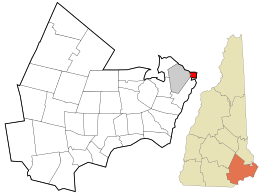New Castle, New Hampshire
| New Castle, New Hampshire | |
|---|---|

Fort Point Light from Ocean Street
|
|
 Location in Rockingham County and the state of New Hampshire. |
|
| Coordinates: 43°04′20″N 70°42′58″W / 43.07222°N 70.71611°WCoordinates: 43°04′20″N 70°42′58″W / 43.07222°N 70.71611°W | |
| Country | United States |
| State | New Hampshire |
| County | Rockingham |
| Incorporated | 1693 |
| Government | |
| • Board of Selectmen | Dave McGuckin, Chair William Stewart Thomas Maher |
| Area | |
| • Total | 2.4 sq mi (6.2 km2) |
| • Land | 0.8 sq mi (2.1 km2) |
| • Water | 1.5 sq mi (4.0 km2) 65.13% |
| Elevation | 20 ft (6 m) |
| Population (2010) | |
| • Total | 968 |
| • Density | 1,210/sq mi (470/km2) |
| Time zone | Eastern (UTC-5) |
| • Summer (DST) | Eastern (UTC-4) |
| ZIP code | 03854 |
| Area code(s) | 603 |
| FIPS code | 33-50980 |
| GNIS feature ID | 0873676 |
| Website | www |
New Castle is a town in Rockingham County, New Hampshire, United States. The population was 968 at the 2010 census. It is the smallest and easternmost town in New Hampshire, and the only one located entirely on islands. It is home to Fort Constitution Historic Site, Fort Stark Historic Site, and the New Castle Common, a 31-acre (13 ha) recreation area on the Atlantic Ocean. New Castle is also home to a United States Coast Guard station, as well as the historic Wentworth by the Sea hotel.
The main island on which the town sits is the largest of several at the mouth of the Piscataqua River and was originally called Great Island. Settled in 1623, an earthwork defense was built on Fort Point which would evolve into Fort William and Mary (rebuilt in 1808 as Fort Constitution). Chartered in 1679 as a parish of Portsmouth, it was incorporated in 1693 and named New Castle after the fort. Until 1719 it included Rye, then called Sandy Beach. The principal industries were trade, tavern-keeping and fishing. There was also agriculture, using the abundant seaweed as fertilizer.
Beginning on June 11, 1682, Great Island experienced a supernatural event—a Lithobolia, or "Stone-Throwing Devil," recorded in a 1698 London pamphlet by Richard Chamberlain. On a Sunday night at about 10 o'clock, the tavern home of George Walton, an early settler and planter, was showered with stones thrown "by an invisible hand." Windows were smashed, and the spit in the fireplace leapt into the air, then came down with its point stuck in the back log. When a member of the household retrieved the spit, it flew out the window of its own accord. The gate outside was discovered off its hinges.Rev. Cotton Mather took an interest in the phenomenon, reporting that:
...
Wikipedia
